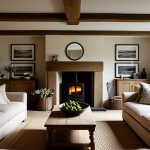Essential DIY Methods for City Apartment Soundproofing
City apartment noise reduction poses unique challenges due to dense urban environments and shared building structures common in the UK. A tailored approach to diy soundproofing can significantly improve tranquility by addressing specific sources of noise such as traffic, neighbours, and communal areas.
Urban noise uniquely impacts UK apartment dwellers because many live in leasehold properties with legal restrictions on structural alterations. It is essential to consider these constraints early when planning DIY noise mitigation. Useful strategies include installing removable acoustic panels or heavy curtains that do not violate lease agreements but provide measurable sound dampening.
This might interest you : Top water-saving techniques for uk pool owners: creative ways to sustain your garden oasis
Most effective DIY soundproofing techniques focus on sealing gaps around windows and doors, layering soft materials on floors, and using mass-loaded vinyl or dense insulation for walls. Each of these methods exploits sound-absorbing or blocking properties without major construction work. Combining several of these low-impact interventions often results in substantial noise reduction, improving comfort and privacy in city apartments.
In particular, understanding UK noise problems and urban acoustic environments helps identify priority areas to treat, enabling more efficient and successful city apartment noise reduction for residents facing common urban living stresses.
In parallel : Discover the perfect shed: your comprehensive guide to crafting the ideal uk garden haven
Essential DIY Methods for City Apartment Soundproofing
When tackling UK noise problems, especially in city apartments, focusing on effective diy soundproofing strategies is crucial. Urban noise often stems from traffic, neighbours, and street activity, impacting residents’ comfort and wellbeing. This uniquely urban challenge calls for tailored noise reduction techniques that work within the constraints of typical leasehold flat conditions.
For city apartments, a soundproofing plan starts with identifying key noise sources and applying targeted methods. Walls can benefit from adding mass with heavy curtains or mounting sound-absorbing panels in a way that respects leasehold restrictions. Windows, a notorious weak point for noise ingress, respond well to affordable secondary glazing options or DIY sealing techniques that reduce unwanted sounds without costly replacements.
Doors often leak sound through gaps; simple diy soundproofing with draft excluders helps significantly while maintaining lease compliance. Floor noise from neighbours below can be diminished using rugs or acoustic mats as practical UK noise reduction measures.
Understanding legal boundaries is essential, as lease agreements might limit the extent of renovations. Always ensure your diy soundproofing approach aligns with both property rules and your noise control goals, striking a balance between effectiveness and practical implementation in city apartments.
Essential DIY Methods for City Apartment Soundproofing
Urban noise uniquely impacts UK apartment dwellers due to factors like traffic, shared walls, and communal spaces typical of city living. City apartment noise reduction requires targeted strategies tailored to these challenges. One important consideration is leasehold restrictions common in UK properties, which often limit permanent structural changes. This means many DIY soundproofing options must be non-invasive and reversible.
Effective diy soundproofing methods include sealing gaps in windows and doors with weatherstripping or draft excluders to block noise paths. Adding heavy curtains or removable acoustic panels helps absorb sound without violating lease agreements. Using dense materials such as mass-loaded vinyl or layered insulation on walls can significantly reduce sound transmission while remaining compliant with building rules.
Urban noise sources vary, so DIY soundproofing efforts should prioritise the most problematic areas first. For instance, traffic noise often comes through windows, while neighbour noise commonly travels through walls and floors. Addressing these with appropriate solutions—such as secondary glazing for windows and rugs or acoustic mats for floors—makes a measurable difference in reducing unwanted sound.
By applying these practical, legal-friendly methods, UK residents can greatly improve apartment tranquility despite the constraints of city living and UK noise problems.
Essential DIY Methods for City Apartment Soundproofing
Understanding UK noise problems is vital when applying diy soundproofing in city apartments. Urban noise sources—traffic, neighbours, and street activity—impact residents uniquely due to the close proximity of flats and building construction common in the UK. Successful city apartment noise reduction requires addressing these specific challenges with practical, non-invasive methods.
Many UK apartments are leasehold, meaning residents face legal restrictions on modifications. This mandates diy soundproofing techniques that avoid permanent structural changes while enhancing sound insulation. For example, using dense materials such as acoustic panels or mass-loaded vinyl on walls adds sound-blocking mass without breaching lease agreements.
Windows often allow significant noise infiltration. Affordable options like secondary glazing or sealing gaps with weatherstripping materials offer substantial noise reduction without costly replacements. Doors also benefit from draft excluders which prevent sound leakage through gaps.
Floor noise, especially from neighbours below, can be tackled by layering thick rugs or acoustic mats, effectively absorbing impact sounds. Combining multiple strategies enhances overall city apartment noise reduction success, balancing practical installation with adherence to UK leasehold limitations.
Adopting these focused, legally compliant diy soundproofing measures enables residents to transform noisy apartments into more peaceful, comfortable living spaces amid demanding urban soundscapes.
Essential DIY Methods for City Apartment Soundproofing
Urban noise challenges in UK apartments require focused diy soundproofing that addresses the unique soundscape of city living. City apartment noise reduction often involves mitigating persistent sounds from traffic, neighbours, and street activity. Urban environments amplify these noises through shared walls, thin partitions, and close proximity, making noise control essential for wellbeing.
Key to successful UK noise problems management is respecting leasehold restrictions that limit structural changes. Therefore, effective DIY methods centre on reversible and non-invasive techniques. Sealing air gaps around windows and doors with weatherproofing strips or draft excluders is a straightforward, cost-efficient approach. These small gaps often serve as major sound paths, so blocking them significantly improves sound insulation.
Walls benefit from added mass or absorption without breaching legal limits. For example, mounting removable acoustic panels or hanging heavy curtains implements diy soundproofing while preserving lease compliance. Floor noise can be reduced by layering thick rugs or acoustic mats, which dampen impact sound from neighbours below.
Prioritising noise sources—traffic entering through windows or neighbour noise via walls—guides targeted efforts, ensuring the most practical city apartment noise reduction results for UK residents living with common urban acoustic challenges.
Essential DIY Methods for City Apartment Soundproofing
DIY soundproofing in UK city apartments demands strategies sensitive to urban noise challenges and typical leasehold restrictions. Urban noise sources, such as traffic and neighbours, uniquely affect apartment dwellers due to proximity and building construction. Effective city apartment noise reduction depends on understanding these elements and applying suitable, non-invasive solutions.
Key to success is addressing common sound paths—windows, doors, and walls—while respecting legal limits on alterations. For windows, sealing gaps with weatherstripping and adding heavy curtains prove effective, especially since window noise often dominates urban sound issues. Walls benefit from adding removable acoustic panels or mass-loaded vinyl to increase density and block sound transmission without structural changes.
Doors frequently leak sound; simple diy soundproofing like draft excluders significantly reduces noise infiltration. Floors, commonly overlooked, can contribute to noise problems particularly in flats with wooden floors; layering rugs or acoustic mats dampens impact sound from neighbours below.
Considering UK noise problems in context, combining these methods enhances overall peace without breaching lease agreements. Each technique offers practical, affordable sound dampening tailored to city apartment realities, ensuring improved living comfort despite challenging urban environments.
Essential DIY Methods for City Apartment Soundproofing
Urban noise profoundly affects UK apartment residents, with UK noise problems stemming mainly from traffic, thin partitions, and shared walls. Effective diy soundproofing targets these unique challenges through practical, legal-friendly methods that improve city apartment noise reduction without breaching leasehold restrictions.
Residents should prioritise sealing all air gaps—especially around windows and doors—with weatherstripping or draft excluders, as these minor openings often serve as major noise pathways. Windows commonly admit the highest levels of traffic noise; secondary glazing or heavy curtains can further reduce sound ingress while complying with lease terms. Walls gain from adding removable acoustic panels or mass-loaded vinyl, increasing density to block sound transmission without structural alterations.
Floor noise, typically impact sounds from neighbours below, responds well to thick rugs or acoustic mats. These materials absorb vibrations, enhancing apartment quietness. Recognising the predominant noise sources in your flat allows you to apply these diy soundproofing techniques strategically, ensuring maximum benefit with minimal disruption.
Considering leasehold legalities is essential, as many UK flats restrict permanent modifications. Thus, reversible, removable solutions that combine sound blocking and absorption offer the best balance in city apartment noise reduction, helping create a more peaceful urban living environment.
Essential DIY Methods for City Apartment Soundproofing
DIY soundproofing in UK city apartments demands focused strategies to tackle persistent UK noise problems like traffic, street activity, and neighbour noise. Urban environments subject residents to amplified sound transmission through thin walls, windows, and shared floors. Therefore, an effective city apartment noise reduction plan prioritises these noise pathways using non-invasive, reversible solutions, especially vital for leasehold properties with legal limits on modifications.
Sealing air gaps around windows and doors with weatherstripping or draft excluders is a practical first step. These gaps often allow the most noise infiltration, making simple sealing remarkably effective. Installing heavy curtains or removable acoustic panels on walls further reduces sound penetration without breaching lease agreements. Mass-loaded vinyl can also be layered underneath removable coverings to add density and block airborne noise.
Floor noise, mainly impact sound from neighbours below, responds well to thick rugs or acoustic mats to absorb vibrations. Combining these techniques addresses distinct UK noise problems sources, offering holistic city apartment noise reduction without structural alterations. This approach respects both building restrictions and the busy urban soundscape, enabling residents to improve quietness and comfort using accessible DIY soundproofing methods suited for typical city flats.
Essential DIY Methods for City Apartment Soundproofing
DIY soundproofing in UK apartments must effectively address UK noise problems while respecting leasehold constraints common in city living. Urban noise sources—traffic, neighbours, and street activity—penetrate through thin walls, windows, doors, and floors, making targeted interventions critical for city apartment noise reduction.
Sealing all gaps around windows and doors using weatherstripping or draft excluders is a fundamental step. These minor openings often act as primary sound paths allowing unwanted noise ingress. Using heavy curtains or removable acoustic panels adds mass and sound absorption to walls without breaching legal restrictions.
Mass-loaded vinyl provides a dense barrier that can be applied behind fabric panels or curtains, increasing sound blockage while remaining removable. For floors, layering thick rugs or acoustic mats dampens impact noise from neighbours below, addressing a common UK noise problems source often overlooked.
Each method focuses on reversible, non-invasive solutions ideal for leasehold flats. Combining these techniques enhances overall city apartment noise reduction and improves living comfort amid persistent urban soundscapes. Understanding the legal boundaries and noise origins allows residents to select the most effective DIY soundproofing strategies tailored to their specific apartment conditions.
Essential DIY Methods for City Apartment Soundproofing
In tackling UK noise problems, a targeted diy soundproofing strategy is essential to achieve meaningful city apartment noise reduction. Urban noise in UK flats often differs from other regions due to dense housing, shared walls, and common leasehold restrictions that limit permanent alterations. Navigating these legal bounds is a foremost consideration, ensuring all interventions comply with property agreements.
Effective DIY methods begin with sealing common sound paths using weatherstripping or draft excluders on doors and windows. These simple fixes block gaps where noise most easily enters. Next, adding mass through removable acoustic panels or heavy curtains helps absorb and reduce airborne noise without breaching leasehold terms. For walls, layering materials like mass-loaded vinyl beneath temporary coverings enhances soundproofing without structural work.
For floors, thick rugs or acoustic mats dampen impact noise from neighbours below, crucial in flats with wooden or hollow flooring. Prioritising noise sources specific to urban living—traffic at windows, neighbour sounds via walls or floors—guides efficient diy soundproofing choices.
Combining these reversible, affordable approaches allows residents to significantly improve comfort and quietness while respecting building rules, effectively addressing the distinct challenges of UK city apartment noise.
Essential DIY Methods for City Apartment Soundproofing
Urban environments in the UK create unique UK noise problems due to dense building layouts and the prevalence of leasehold apartments. Effective diy soundproofing must therefore focus on strategies that address key noise paths while respecting legal restrictions on structural changes common in UK flats. This balance is essential to achieve meaningful city apartment noise reduction without breaching lease agreements.
Sealing gaps around windows and doors is one of the most effective first steps. Small cracks and poorly fitting frames let in traffic and street noise, so applying weatherstripping or draft excluders can significantly reduce this sound infiltration. Windows often act as major conduits for external noise; affordable solutions like heavy curtains or temporary secondary glazing add much-needed mass and sound absorption without permanent installation.
Walls and floors also require attention. Adding removable acoustic panels to walls increases density and cuts airborne noise, while layering thick rugs or acoustic mats on floors dampens impact sounds from neighbours below. These DIY methods combine sound blocking and absorption, tackling the distinct urban noise sources impacting UK apartments.
In sum, a carefully considered mix of reversible, non-invasive diy soundproofing techniques can dramatically improve city apartment noise reduction, ensuring better living comfort despite common urban challenges and leasehold constraints.
Essential DIY Methods for City Apartment Soundproofing
Urban noise in UK apartments originates mainly from external traffic, neighbour activity, and communal spaces, posing unique challenges for city apartment noise reduction. Due to close living quarters and thin partitions, noise easily transmits through windows, walls, doors, and floors. Effective diy soundproofing must address these weak points strategically.
For most UK flats, especially leasehold properties, legal restrictions limit permanent structural changes. Hence, non-invasive, reversible solutions are preferred. Prioritise sealing gaps around windows and doors with weatherstripping or draft excluders to block primary sound paths. Windows are critical as they often allow high levels of traffic noise; using heavy curtains or adding removable acoustic panels enhances sound absorption without breaching lease terms.
Walls benefit from increased mass via temporary installations such as acoustic panels or layers of mass-loaded vinyl concealed beneath fabric hangings. These methods block airborne noise effectively while respecting leasehold constraints. Floors, prone to impact noise from neighbours below, respond well to thick rugs or acoustic mats to dampen vibrations.
By focusing on these target areas—windows, walls, doors, and floors—UK residents can apply practical diy soundproofing tactics that mitigate common UK noise problems and improve apartment comfort within legal boundaries.




